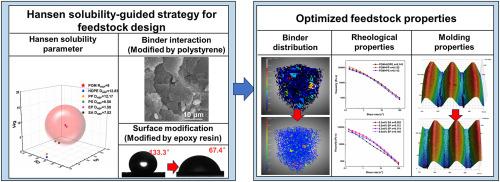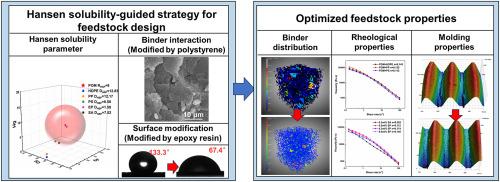通过汉森溶解度导向设计解锁粉末粘合剂原料近净成型的卓越分散均匀性
IF 9.7
2区 材料科学
Q1 MATERIALS SCIENCE, MULTIDISCIPLINARY
引用次数: 0
摘要
以热塑性塑料为原料的粉末注射成型和基于挤压的3D打印是关键的制造技术。原料设计对产品质量有重要的影响,但仍然缺乏系统的科学方法。在这项研究中,我们提出了一种Hansen溶解度参数(HSP)指导策略,利用聚合物分子间相互作用来设计和优化基于聚甲醛(POM)的金属陶瓷粉末粘合剂体系。在POM粘结剂基质中评估不同的功能聚合物/基团。结果表明,聚苯乙烯(PS)改善了粘结相的分散均匀性,降低了原料粘度和结晶倾向。环氧树脂(EP)通过化学键合吸附在粉末表面,通过与POM相容性的强相互作用,提高粉末和粘结剂的分散性。与传统的基于pom的原料相比,hsp优化的原料表现出更好的相分散,减少粘合剂聚集,增强脱粘和成型性能。这项工作验证了hsp指导策略作为热塑性原料的可行设计工具,提供了适用于粉末注射成型和基于挤压的3D打印的设计框架。本文章由计算机程序翻译,如有差异,请以英文原文为准。


Unlocking superior dispersion uniformity in powder-binder feedstock for near net-shaping via Hansen solubility-guided design
Powder injection molding and extrusion-based 3D printing which using thermoplastic feedstock, are pivotal manufacturing technologies. Feedstock design critically influences product quality, yet a systematic scientific methodology remains lacking. In this study, we proposed a Hansen solubility parameter (HSP)-guided strategy leveraging polymer intermolecular interaction to design and optimize polyformaldehyde (POM)-based binder systems for cermet powder. Different functional polymers/groups were evaluated within the POM binder matrix. We demonstrated that polystyrene (PS) improved the dispersion uniformity of the binder phase and reduced the feedstock viscosity and crystallization tendency. Epoxy resin (EP) adsorbed onto the powder surface through chemical bonding, improving powder and binder dispersibility through its strong interaction with POM compatibility. The HSP-optimized feedstock demonstrated improved phase dispersion, reduced binder aggregation, and enhanced debinding and molding properties compared to conventional POM-based feedstock. This work validated the HSP-guided strategy as a viable design tool for thermoplastic feedstocks, providing a design framework applicable to both powder injection molding and extrusion-based 3D printing.
求助全文
通过发布文献求助,成功后即可免费获取论文全文。
去求助
来源期刊

Materials Today Physics
Materials Science-General Materials Science
CiteScore
14.00
自引率
7.80%
发文量
284
审稿时长
15 days
期刊介绍:
Materials Today Physics is a multi-disciplinary journal focused on the physics of materials, encompassing both the physical properties and materials synthesis. Operating at the interface of physics and materials science, this journal covers one of the largest and most dynamic fields within physical science. The forefront research in materials physics is driving advancements in new materials, uncovering new physics, and fostering novel applications at an unprecedented pace.
 求助内容:
求助内容: 应助结果提醒方式:
应助结果提醒方式:


